Femto Size Coupler Line
über
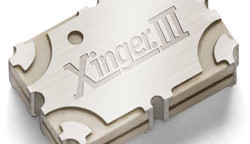
In order to more accommodate both data-hungry, well-served subscriber markets like Europe and North America, and emerging markets like India, Brazil, and China where basic, lower-cost cellular plans and wireless internet access are the current objective, participants at all levels of the wireless infrastructure segment continue to evolve. One sign of this process is the increased appearance of lower-power, small cell base stations that are designed to be cost effective and easy to deploy and maintain. Another indication is the need for lower cost, higher performing passive components – in ever-smaller package sizes – at the sub assembly level.
As a case in point, Anaren Microwave has introduced a new family of Xinger®-III brand, Femto-sized hybrid and directional couplers offering noteworthy advances in both electrical and physical characteristics. The line includes five hybrid coupler part numbers and two directional couplers covering 700 to 3800 MHz with performance tuned for UMTS, AMPS, GSM, WCDMA, LTE and WiMAX applications.
Footprint Friendly
As RF amplifier designers know, standard coupler footprints for all bands and coupling values make both board design and board population/production stages easier and more efficient. This is especially true given the current emphasis on using one standard board layout across multiple applications or systems. It can also be a benefit later in a board layout’s life cycle, should any of the components surrounding the coupler need to be swapped out or updated.
Measuring 0.200 × 0.125 inches (5.08 × 3.18 mm) and reflecting the latest iteration of the company’s well known multi-layering innovations, this new Femto-size coupler line is quite literally a fit for such size-minded manufacturers, offering an industry-standard, much reduced footprint without any sacrifice in performance compared to Anaren’s larger, still available counterparts.
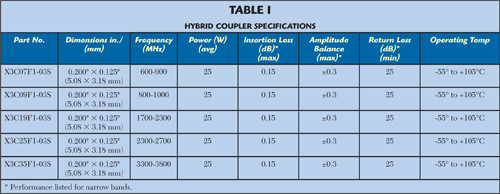
Hybrids
Even in this compact form factor, the new Xinger-III Femto hybrids offer a low insertion loss of less than 0.15 dB and tight amplitude balance and high isolation – which can be critical to OEMs seeking to squeeze every last bit of performance out of their systems.
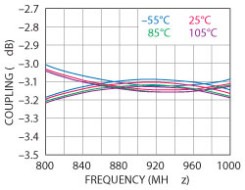
(feeding port 1).
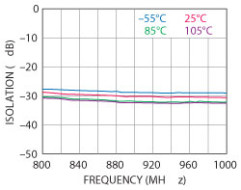
(feeding port 1).
One example from the family is model X3C09F1-03S, which can be used for applications in 800 to 1000 MHz. This part exhibits a maximum insertion loss (IL) of 0.15 dB maximum over its full frequency range and at extreme temperature ranges that are not a-typical in today’s stations – from -55°C all the way up to 105°C. This small, 90 degree coupler also achieves 23 dB minimum isolation from 800 to 1000 MHz with 26 dB minimum isolation from 869 to 894 MHz and 925 to 960 MHz (see Table 1). The same part, which is a fair representative of the entire family, also offers a maximum VSWR of 1.15:1 from 800 to 1000 MHz, with maximum VSWR of 1.12:1 from 869 to 894 MHz and maximum VSWR of 1.12:1 from 925 to 960 MHz. The hybrid’s small size and carefully controlled transmission lines result in worse-case amplitude balance of ±0.3 from 800 to 1000 MHz. And the phase balance is within ±4 degrees from 800 to 1000 MHz, within ±2 degrees of 90 degrees from 869 to 894 MHz, and within ±2 degrees of 90 degrees from 925 to 960 MHz (see Figures 1 to 4). These are high performance specifications for the hybrid category and should be of interest to the RF system designer seeking to maximize performance. Anaren currently derates all parts assuming RoHS compliant SAC (96.5Sn3.0Ag0.5Cu) solder.
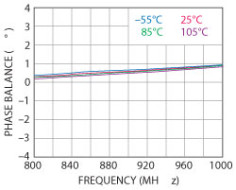
(feeding port 1).
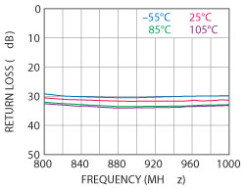
(feeding port 1).
Directionals
The new line-up of Xinger-III Femtos also offer very low loss for the directional couplers category (max 0.1 dB). As an example from this branch of the family, 20 dB directional coupler model number X3C19F1-20 can handle 25 W CW input power from 1400 to 2700 MHz in a package measuring 0.200 × 0.125 inches (see Table 2). The mean coupling is 20.5 and varies 1.50 dB across the full frequency range, with maximum insertion loss of 0.1 dB and maximum VSWR of 1.22:1. The minimum full-band directivity is 20 dB, with directivity of 25 dB and insertion loss of only 0.05 dB from 1805 to 1880 MHz, 1930 to 1990 MHz and 2110 to 2170 MHz (see Figures 5 to 8).

Other Advantages
Beyond electrical performance, these Femto couplers afford other useful characteristics. Most noteworthy, their softboard construction offers coefficient of thermal expansion (CTE) properties that match commonly used FR4, G-10, RF-35, RO4003 and polyimide. Of importance particularly in the aforementioned, hotter running micro-cell stations – this material choice can help avoid solder cracks that are not uncommon when ceramic solutions operate at high temperatures.

(feeding port 1).
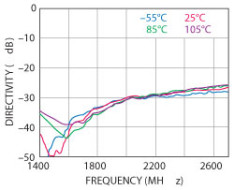
(feeding port 1).
Additionally, these new Femtos are RoHS and REACH compliant. They offer very stable RF performance up to 105 degrees, making them well-suited to today’s high temperature micro cells (see Figures 1-6). And should mounting temperatures exceed 105°C, they’ll still perform reliably provided the input power is derated per the derating curve on each part’s datasheet.
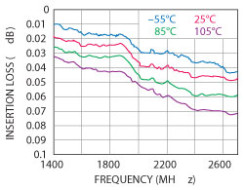
(feeding port 1).
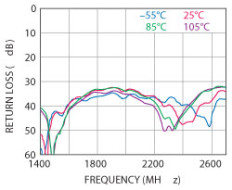
(feeding port 3).
Anaren Microwave,
Syracuse, NY
(800) 411-6496,
www.anaren.com
From: http://www.microwavejournal.com/articles/20781-femto-size-coupler-line


Diskussion (0 Kommentare)